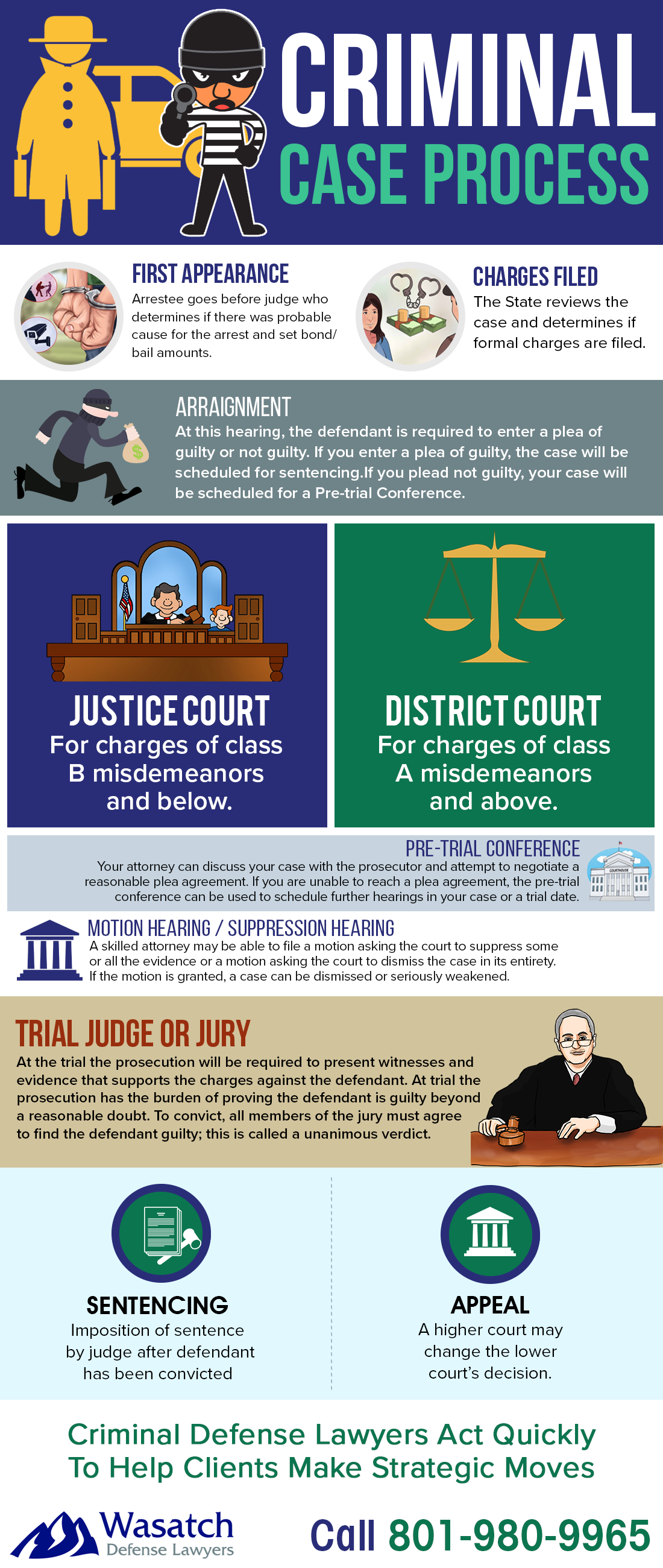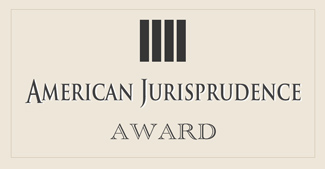Dealing with the legal system in any capacity can be quite trying, especially when you are the one with your life on the line. Learning as much as you can about the criminal case procedures in your state is a good place to start. That said, without a legal expert to support and guide you along the way, it could prove difficult to make it through unscathed.If you or a loved one has been arrested in Utah, it is extremely important to have aggressive and experienced legal representation on your side. To set up a free, confidential case evaluation, call Wasatch Defense Lawyers at 801-980-9965. Our phone lines are always open, and we can make jail cell visits in case of emergencies.
Brief Overview of Utah Criminal Case Process
In cases that involve a felony, there are a couple extra steps in the beginning of the criminal case process.
Preliminary Hearing (felony) First Appearance
During the preliminary hearing, a judge will determine if there is sufficient evidence to suggest a trial is warranted. At this time, witnesses will be called to give testimony and evidence will be exhibited to confirm there is enough to support a trial. If the judge is convinced that there is enough evidence to tie the defendant to the crime, the defendant will be bound over for trial. If the judge finds there is not enough evidence, the case will be dismissed. The official charges may also be altered during the preliminary hearing, if necessary.
Arraignment
In cases that only involve misdemeanors or lesser crimes, the accused will skip straight to this court appearance. During an arraignment, the defendant must enter a plea. The most commonly heard pleas are ‘guilty’ or ‘not guilty,’ which are fairly self-explanatory. However, there are two other plea options that a defendant may opt to use; these are ‘no contest’ and ‘Alford plea.’ Pleading ‘no contest’ has the same procedural ramifications as a ‘guilty’ plea, without expressly confessing to the crime. The accused is essentially saying that the prosecutor would likely win the trial with the case he/she has built. Similarly, an ‘Alford plea’ provides the defendant the same opportunity of avoiding a confession by taking a plea bargain or lesser sentence. In certain instances, a judge may not accept either of these pleas. If the defendant pleads ‘guilty,’ a date for sentencing will be scheduled. If the defendant pleads ‘not guilty,’ pre-trial and trial dates are set.
Pre-Trial Motions
Prior to the start of a trial, the prosecution and defense may choose to file a motion, or a written proposal to the judge to issue an order. Both sides may file any number of official requests, which may include an order to suppress evidence or prior convictions by the defendant. They must be filed 5 days before the trial begins, and all should be heard and approved/rejected by the judge in order for the trial to move forward.
Pre-Trial Conference
A pre-trial conference may also take place, wherein both parties of the court case discuss the possibility of a settlement. If a compromise cannot be reached, the case will proceed to a trial. The prosecution and defense may also discuss a plea bargain at this time. If the defendant will agree to plead ‘guilty’ or ‘no contest,’ he or she may be able to negotiate down to a reduced charge or have one or more dropped. The judge is not a part of the plea-bargaining process, however, he/she must approve the proposal, as does the defendant. If the parties do accept the proposed disposition, the defendant will be sentenced without a trial.
Trial Procedure
The trial procedure, itself, is similar to what you may have seen in a primetime crime drama. If you haven’t experienced it yourself firsthand or been through jury duty, here is a short breakdown of what happens:
- Jury Selection: During this step, the judge or lawyers question a panel of prospective jurors to determine if they will be good candidates to join the jury. Questioning will revolve around a person’s background and beliefs to see if they might be biased or prejudiced in any way that might negatively affect the trial. An unlimited number of people may be excused from the selection with cause. Both sides of the case may excuse a person without cause, also known as a peremptory challenge, but each side may only do this a limited number of times.
- Opening Statement: Lawyers from each side will make a case for their point of view. This will include an overview of the case, the evidence they will be exhibiting, and what they expect to prove by the end of the trial. The defense can choose to wait to give a statement until after the prosecution rests or choose not to give one at all.
- Prosecution Evidence: At this point, the prosecution will begin to call its witnesses to the stand for examination. Witnesses will be questioned about their involvement or accounts of the crime committed. Once the prosecution has completed its round of questioning, the defense may choose to ask their own questions of the witnesses, also known as cross-examination. Once the defense is finished with their round of questioning, the prosecution may re-examine the same witnesses, also known as re-directing. Evidence will also be shared at this time.
- Defense Evidence: After the prosecution has rested its case, the defense can now begin calling its own witnesses. The hope is to disprove the prosecution’s case and clear the defendant of the charges against him/her. The same process of examining, cross-examining, and re-directing will take place.
- Rebuttal: At this time, the prosecution may call witnesses back to the stand to rebut any of the testimony presented by the defense’s case. The defense will also have a chance to rebut the prosecution’s rebuttal which is called a sur-rebuttal.
- Jury Instructions: The judge will remind the jury of the law they need to follow and provide instructions on how to proceed. In the situation of a criminal case, the jury must agree that the defendant is guilty beyond reasonable doubt in order to be convicted.
- Closing Arguments: During the closing arguments, both lawyers will go back over all of the testimony, facts, and evidence presented during the trial in an effort to sway the jury or judge in direction or the other. As in the opening arguments, the prosecution will speak first, followed by the defense. The prosecution will then have a chance to respond to the defense. Both parties do have the option of waiving a closing argument.
- Jury Deliberations: After all closing arguments have been heard, the jury will retire to the jury room to discuss the case and come up with their verdict.
- Verdict: The jury’s verdict must be unanimous. It must be read in an open court in front of the defendant, though the defendant may request to not be present. The jury may choose from four possible verdicts: ‘guilty,’ ‘not guilty,’ ‘not guilty by reason of insanity,’ and ‘guilty and mentally ill.’ During deliberations, if the jury can not come to a unanimous decision, this would be considered a “hung” jury. The judge may then declare a mistrial and order a new one.
- Sentencing: Following a plea or verdict of ‘guilty,’ the defendant has the right to be sentenced between 2-45 days following a conviction unless the defendant waives this right. In that case, he or she will be sentenced on the same day as convicted.
Appeals
After a trial ends, a ‘guilty’ verdict may be appealed. There are many potential grounds for appeal in a criminal case. One such reason includes legal error committed at any stage of the criminal justice process. A legal error can refer to any one of the following: allowing inadmissible evidence (i.e. evidence obtained in violation of the defendant’s constitutional rights), lack of sufficient evidence to support a verdict of guilty, and mistakes in the judge’s charge to the jury. A verdict may also be appealed due to misconduct on behalf of the jurors.




